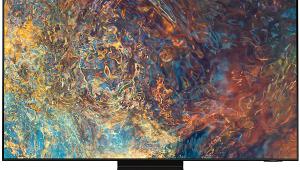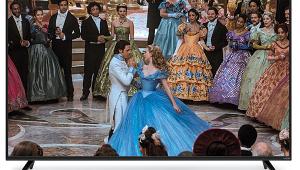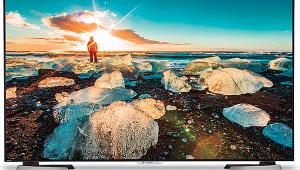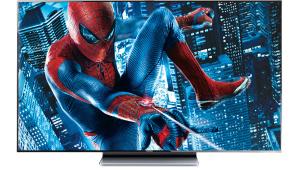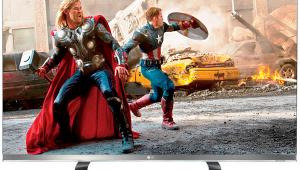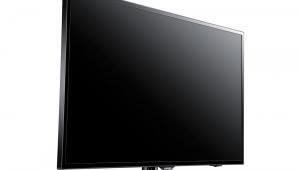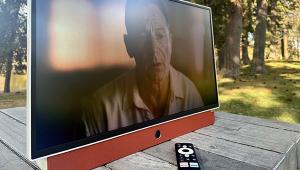JVC LT-47X899 LCD HDTV Page 2
 The Big Picture
The Big Picture
JVC’s decision to limit viewers’ options in its 120-Hz sets is disappointing, but the algorithm it uses to perform its 120-Hz interpolation appears to be more sophisticated than what many competing 120-Hz designs use. I saw no artifacts. The set also incorporates some nondefeatable noise reduction—JVC’s i-Clear Motion NR. Still, I didn’t see any indication that the set compromised its resolution or other important picture characteristics, as is often the case when a display uses such “image enhancement” processing. Most important, the set’s video look on film wasn’t quite as obvious as it often is in similar designs. That little voice that often whispers, “Filmed on HD video” with this type of image manipulation may not have been completely silenced, but it was heavily muffled.
Everyone responds differently to such processing. You’ll have to make up your own mind on the issue, based on viewing the set in a store. But be sure to use a familiar, film-based source if possible, not the store’s demo loop.
The JVC’s 480i-to-1080p video processing was fair to good on most of my tests, including real-world torture tests. However, it did fail the waving-flag test (visible jaggies) and the 2:2 pulldown test (video cadence) at any setting of its Natural Cinema control. But it performed well in 1080i-to-1080p tests and accurately deinterlaced both video- and film-based sources. It also properly recognized 3:2 pulldown where it was present. It did show some flicker on Mission: Impossible III’s Vatican steps sequence (chapter 8). It stumbled on difficult edits and did not respond cleanly to 2:2 pulldown. But it displayed no consistent video processing problems on real-world program material.
The JVC has a wider off-axis viewing angle than most LCD sets. However, once you get beyond 45 degrees, the image starts to gradually lighten and wash out.
The biggest plus is the set’s exceptional resolution and sense of depth—at least on bright program material. It reminded me just how spectacular Pirates of the Caribbean: The Curse of the Black Pearl looks on Blu-ray. The opening scenes, which include the segment where Jack Sparrow (sorry, Captain Jack Sparrow) rescues Elizabeth Swan, are generally brightly lit. This makes them pop as well here as I’ve seen from any other display. A pair of Pioneer Blu-ray demo discs (with content ranging from film clips to video productions) didn’t look as spectacular as they do on Pioneer’s pricey KURO plasmas, but they didn’t disappoint me on the more affordable JVC. Even the dark scenes on these discs looked respectable, largely because they mainly contained bright images in front of a black background. These scenes are far easier for an LCD to reproduce than dark scenes with little inherent contrast.
That’s probably why Harry Potter and the Order of the Phoenix on HD DVD and U-571 on Blu-ray didn’t look quite as compelling. They both contain a lot of mixed-brightness scenes. Some of them looked quite dark overall. When I watched these discs, I discovered the usefulness of the set’s Dynamic Gamma control. I normally dislike such image manipulations, but Dynamic Gamma gave the JVC its only route to acceptable—though far from impeccable—shadow detail. On some program material, including Potter, Dynamic Gamma resulted in a slightly less natural look in the form of a slight glare on bright objects in dark scenes. Overall it was a plus; without it, the set often crushed shadow detail.
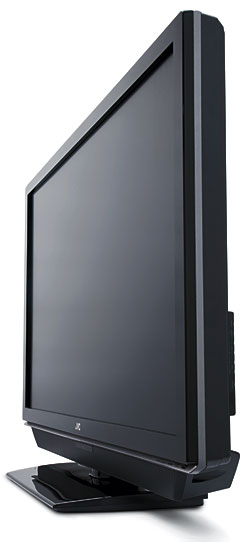 If you’re not particularly critical, or if you do most of your viewing in average room lighting, you might not notice the JVC’s grayish blacks. But like most LCDs, you can’t miss them in a dimly lit room. Still, the set’s black level actually measured somewhat better than most modern LCDs. But don’t cue the band. I’d rate the JVC’s black level as satisfactory but not inspiring.
If you’re not particularly critical, or if you do most of your viewing in average room lighting, you might not notice the JVC’s grayish blacks. But like most LCDs, you can’t miss them in a dimly lit room. Still, the set’s black level actually measured somewhat better than most modern LCDs. But don’t cue the band. I’d rate the JVC’s black level as satisfactory but not inspiring.
The set’s colors often looked stunning. Nothing about them will likely look obviously wrong to the average viewer. Yes, green foliage often had that slightly Crayola-tinted, oversaturated look, but the color palette was subjectively pleasing overall. And that includes the all-important fleshtones.
Pleasing or not, the set’s color gamut (the locations of its color points) doesn’t follow the HD color standard closely, particularly with green. I wish it were more accurate. (You can’t correct it with the set’s Color Management system.) Fortunately, color-gamut errors look less obvious than poor gray-scale tracking (how well the set’s color temperature tracks the standard D65 white point from the darkest blacks to the whitest whites). After calibration, the JVC’s gray-scale tracking was excellent.
Conclusions
It’s hardly to the JVC’s benefit that I came to it right after I reviewed the latest Pioneer KURO plasma (see my review on page 60). The blacks on that set are so compelling that no LCD (short of perhaps a design with LED backlighting and local dimming) will look good next to it. And the JVC’s blacks, in general, have the same limitations that most LCD sets do.
But despite this, I was impressed that the JVC conveyed such a convincing sense of depth on bright scenes. I always associate that quality with having great blacks to form a solid foundation for the image. I suspect the set’s dimensionality is the result of its other important strength: superb resolution, particularly in 1080i and 1080p.
I’ll end with a final pitch to manufacturers to include a way to disable the interpolation that comes with those added 120-Hz frames. For me, the JVC’s undefeatable frame interpolation is a significant shortcoming. Frame interpolation can be useful on some program material, and the JVC does it better than most. However, the ultimate choice to use it should be the viewer’s.
- Log in or register to post comments
